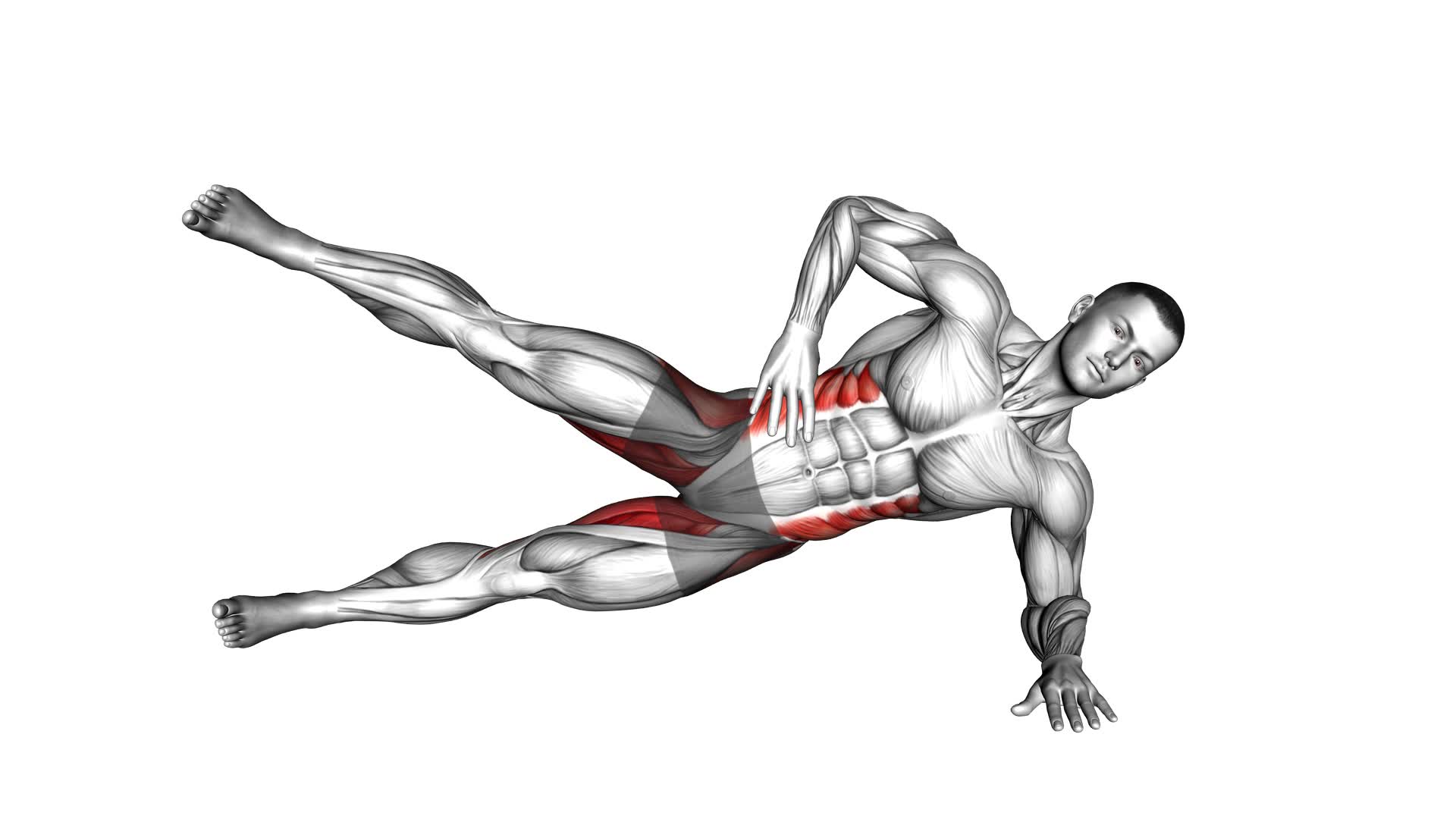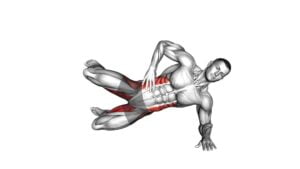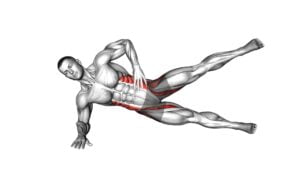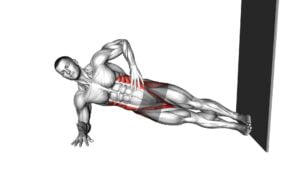Side Plank Leg Lift (male) – Video Exercise Guide & Tips

Looking to strengthen your core and sculpt your legs?
Watch This Exercise Video
Check out the Side Plank Leg Lift exercise! In this video exercise guide, we'll show you how to properly perform this move for maximum effectiveness. Avoid common mistakes and discover modifications for beginners as well as advanced variations for a greater challenge.
With our tips, you'll be able to maximize your results and achieve your fitness goals.
Let's get started!
Key Takeaways
- Side plank leg lift targets core muscles, abs, obliques, and lower back.
- Proper form and technique include engaging core muscles, aligning the supporting arm beneath the shoulder, and focusing on stability and control.
- Core engagement tips involve contracting abdominal muscles, activating deep core muscles, engaging obliques, controlling leg lift using core muscles, and visualizing core muscles working throughout the exercise.
- Proper shoulder alignment is important to distribute load evenly, engage correct muscles effectively, and reduce the risk of strain or overuse injuries.
Benefits of Side Plank Leg Lift
To maximize the effectiveness of your side plank leg lift, it's important to understand the benefits it offers.
This exercise not only targets your core muscles, but also strengthens your glutes. The side plank leg lift engages your core muscles, including your abs, obliques, and lower back, to stabilize your body in the side plank position.
As you lift your leg, you activate your glute muscles, particularly the gluteus medius and gluteus minimus. These muscles play a crucial role in stabilizing your pelvis and hips, improving your overall balance and stability.
By incorporating the side plank leg lift into your workout routine, you can enhance your core activation and glute strengthening, leading to improved athletic performance and reduced risk of injuries.
Proper form and technique are essential for maximizing the benefits of this exercise, so let's now dive into the next section to learn about the correct way to perform the side plank leg lift.
Proper Form and Technique
To perform the Side Plank Leg Lift exercise with proper form and technique, there are a few key points to keep in mind.
- Firstly, focus on engaging your core muscles throughout the entire movement to maintain stability.
- Secondly, pay attention to your shoulder alignment, ensuring that your supporting arm is directly beneath your shoulder to prevent strain.
- Lastly, if you're a beginner, it's important to modify the exercise by starting with a bent knee position or by using a support, such as a yoga block, until you build up enough strength and stability.
Core Engagement Tips
Engage your core muscles by squeezing them tightly throughout the Side Plank Leg Lift exercise. This will help you maintain stability and maximize the benefits of the workout. Here are some core engagement tips to ensure proper form and technique:
- Keep your abdominal muscles contracted throughout the exercise to support your spine.
- Focus on pulling your belly button towards your spine to activate your deep core muscles.
- Avoid letting your hips sag or rotate during the movement. Engage your obliques to keep your body aligned.
- Breathe deeply and exhale as you lift your leg, using your core muscles to control the movement.
- Visualize your core muscles working as you perform the exercise, maintaining a strong and stable center.
Shoulder Alignment Importance
As you perform the Side Plank Leg Lift exercise, it's important to prioritize proper shoulder alignment for optimal form and technique. The importance of shoulder stability can't be overstated, as it not only enhances your performance but also prevents shoulder injuries.
Maintaining proper shoulder alignment during the exercise helps to distribute the load evenly and engage the correct muscles effectively. When your shoulders are aligned, the risk of strain or overuse injuries is significantly reduced. To ensure proper alignment, make sure your shoulder blades are pulled down and back, and your shoulders are stacked directly over your wrists. Avoid shrugging your shoulders or collapsing into them.
Modifications for Beginners
Maintain proper form and technique as a beginner by making modifications to the Side Plank Leg Lift exercise. Here are some beginner modifications and starting positions to help you get started:
- Start with a modified side plank by bending your bottom knee and placing it on the ground for added stability.
- If the leg lift feels too challenging, start by just lifting your top leg slightly off the ground and gradually increase the range of motion as you get stronger.
- Use a wall or a sturdy piece of furniture for support. Place your bottom arm on the wall or furniture to help you maintain balance and stability.
- If balancing on your hand is difficult, try using your forearm instead. This can provide more support and make the exercise easier.
- Don't push yourself too hard in the beginning. Take breaks when needed and gradually increase the duration and intensity of the exercise as you become more comfortable.
Common Mistakes to Avoid
One common mistake to avoid when performing the side plank leg lift exercise is to let your hips sag. Proper form is essential for maximizing the effectiveness of this exercise and minimizing the risk of injury. When your hips sag, it puts excessive strain on your lower back and reduces the engagement of your core muscles.
To maintain proper form, focus on aligning your body in a straight line from head to toe. Engage your core muscles to stabilize your body and prevent your hips from drooping. Imagine creating a straight line from your shoulder to your ankle.
Another common mistake to avoid is lifting your leg too high. While it may be tempting to lift your leg as high as possible, it can compromise your stability and increase the risk of injury. Instead, focus on lifting your leg to a comfortable height while maintaining control and stability.
Lastly, avoid rushing through the exercise. Performing the side plank leg lift too quickly can lead to sloppy form and reduced effectiveness. Take your time and focus on maintaining proper alignment and control throughout the movement.
Modifications for Beginners
To make the side plank leg lift exercise more accessible for beginners, you can gradually increase the duration of the hold. This modification allows you to build foundational strength while gradually challenging your core and stabilizing muscles.
Here are five modifications for beginners to consider:
- Start with a shorter hold: Begin by holding the side plank position for 10-15 seconds and gradually increase the duration as you build strength.
- Drop the bottom knee: If the full side plank position is too challenging, you can modify by dropping your bottom knee to the ground. This reduces the load on your core and makes it easier to maintain balance.
- Use a support: Place your bottom hand on the ground for added stability and support. This modification can help you maintain proper form and reduce the strain on your core.
- Perform the exercise against a wall: Position yourself sideways against a wall and use it for support. This modification provides extra stability and allows you to focus on building strength in your core and hips.
- Try a modified side plank on the elbow: Instead of fully extending your arm, lower yourself onto your forearm for a modified side plank. This variation reduces the demand on your core and allows you to focus on building strength in a more comfortable position.
Advanced Variations for a Greater Challenge
Ready to take your side plank leg lift to the next level?
Advanced variations will challenge your core strength, enhance your balance, and improve your stability.
These progressions will push your limits and help you achieve greater results.
Get ready to amp up your workout and see the difference in your overall strength and stability.
Core Strength Progressions
Looking for a more challenging way to strengthen your core? Core strength progressions can help take your core stability exercises to the next level. Here are some advanced variations of plank exercises that will provide a greater challenge:
- Plank with Knee Tucks: Start in a high plank position and alternate bringing your knees towards your chest, engaging your core and maintaining a straight line from head to toe.
- Spiderman Plank: Begin in a high plank position and bring your right knee towards your right elbow, then return to the starting position and repeat with the left knee.
- Plank with Shoulder Taps: While in a high plank position, lift one hand and tap the opposite shoulder, alternating sides while keeping your core stable.
- Plank Jacks: Start in a high plank position and jump your feet out wide, then jump them back together, engaging your core throughout.
- Side Plank with Hip Dips: Begin in a side plank position and lower your hips towards the ground, then lift them back up, focusing on engaging your obliques.
Incorporating these advanced plank variations into your core workout routine will help you boost your core strength and stability.
Balance and Stability Enhancements
As you progress in your core strength training, it's time to step up the challenge with advanced variations that focus on balance and stability. These advanced exercises not only enhance your core strength but also improve coordination and increase flexibility.
By incorporating movements that challenge your balance, such as single-leg variations or adding unstable surfaces like a balance board or Bosu ball, you can engage more muscles and enhance your overall stability.
Additionally, exercises that require you to move through different planes of motion, like side planks with leg lifts, can improve your coordination and proprioception.
To further increase flexibility, you can incorporate dynamic stretches and movements that require a greater range of motion.
Remember to start with proper form and gradually increase the difficulty to avoid injury and maximize results.
Tips for Maximizing Results
To maximize your results, incorporate these tips into your Side Plank Leg Lift exercise routine:
- Focus on form:
Maintaining proper form is crucial for maximizing efficiency and preventing injuries. Keep your body aligned in a straight line from head to toe, engage your core muscles, and avoid sagging or arching your back.
- Gradually increase difficulty:
Start with a level that challenges you but allows you to maintain proper form. As you become stronger and more comfortable, gradually increase the difficulty by adding ankle weights or performing the exercise on an unstable surface, such as a Bosu ball.
- Breathe properly:
Remember to breathe throughout the exercise. Inhale deeply through your nose on the way down and exhale forcefully through your mouth as you lift your leg.
- Maintain control:
Avoid rushing through the movement. Focus on maintaining control and stability throughout the exercise to fully engage your muscles and maximize the benefits.
- Listen to your body:
Pay attention to any discomfort or pain during the exercise. If you experience any pain, modify the exercise or consult a fitness professional to ensure you're performing it correctly and safely.
Frequently Asked Questions
How Many Calories Can I Burn by Doing the Side Plank Leg Lift Exercise?
You can burn a significant number of calories by doing the side plank leg lift exercise. It's an effective way to engage your core muscles and strengthen your legs.
The side plank position targets your obliques, while the leg lift adds an extra challenge for your glutes and thighs.
By combining these movements, you'll not only burn calories but also improve your overall balance and stability.
Keep up the good work!
Can the Side Plank Leg Lift Exercise Help Reduce Love Handles?
The side plank leg lift exercise is an effective core strengthening exercise that can help reduce love handles. By targeting the oblique muscles, this exercise helps to tone and tighten the sides of your waist, reducing the appearance of love handles.
Additionally, engaging your core during this exercise can help to strengthen your abdominal muscles, leading to overall reduction in belly fat.
Incorporate this exercise into your routine for maximum results.
Is It Safe to Perform the Side Plank Leg Lift Exercise if I Have a History of Lower Back Pain?
If you have a history of lower back pain, it's important to be cautious when performing the side plank leg lift exercise. This exercise puts strain on the lower back, which can exacerbate your pain.
It may be best for you to consider modifications to the side plank or alternative exercises that are more gentle on the lower back. Always consult with a healthcare professional before starting any new exercise program, especially if you have a preexisting condition.
How Often Should I Incorporate the Side Plank Leg Lift Exercise Into My Workout Routine for Optimal Results?
To achieve optimal results with the side plank leg lift exercise, it's important to incorporate it into your workout routine regularly. The frequency will depend on your fitness level and goals.
Start by performing the exercise 2-3 times a week and gradually increase as you get stronger.
Additionally, you can vary the exercise by adding progressions such as holding a weight or using resistance bands. This will help challenge your muscles and further improve your results.
Can the Side Plank Leg Lift Exercise Help Improve My Balance and Stability?
Improving your balance and stability is possible with the side plank leg lift exercise. By engaging your core muscles and increasing hip mobility, this exercise challenges your body's stability and helps you develop better balance.
Incorporating this exercise into your workout routine regularly can yield optimal results. Remember to maintain proper form and gradually increase the intensity to avoid injury and maximize the benefits of this exercise.
Conclusion
In conclusion, the side plank leg lift is a highly effective exercise for targeting the core, hips, and glutes. By maintaining proper form and technique, you can maximize the benefits of this exercise while avoiding common mistakes.
Beginners can modify the exercise to suit their fitness level, while advanced individuals can challenge themselves with variations for an added difficulty.
By following these tips and consistently incorporating this exercise into your routine, you can achieve great results.

Author
Years ago, the spark of my life’s passion ignited in my mind the moment I stepped into the local gym for the first time. The inaugural bead of perspiration, the initial endeavor, the very first surge of endorphins, and a sense of pride that washed over me post-workout marked the beginning of my deep-seated interest in strength sports, fitness, and sports nutrition. This very curiosity blossomed rapidly into a profound fascination, propelling me to earn a Master’s degree in Physical Education from the Academy of Physical Education in Krakow, followed by a Sports Manager diploma from the Jagiellonian University. My journey of growth led me to gain more specialized qualifications, such as being a certified personal trainer with a focus on sports dietetics, a lifeguard, and an instructor for wellness and corrective gymnastics. Theoretical knowledge paired seamlessly with practical experience, reinforcing my belief that the transformation of individuals under my guidance was also a reflection of my personal growth. This belief holds true even today. Each day, I strive to push the boundaries and explore new realms. These realms gently elevate me to greater heights. The unique combination of passion for my field and the continuous quest for growth fuels my drive to break new ground.







